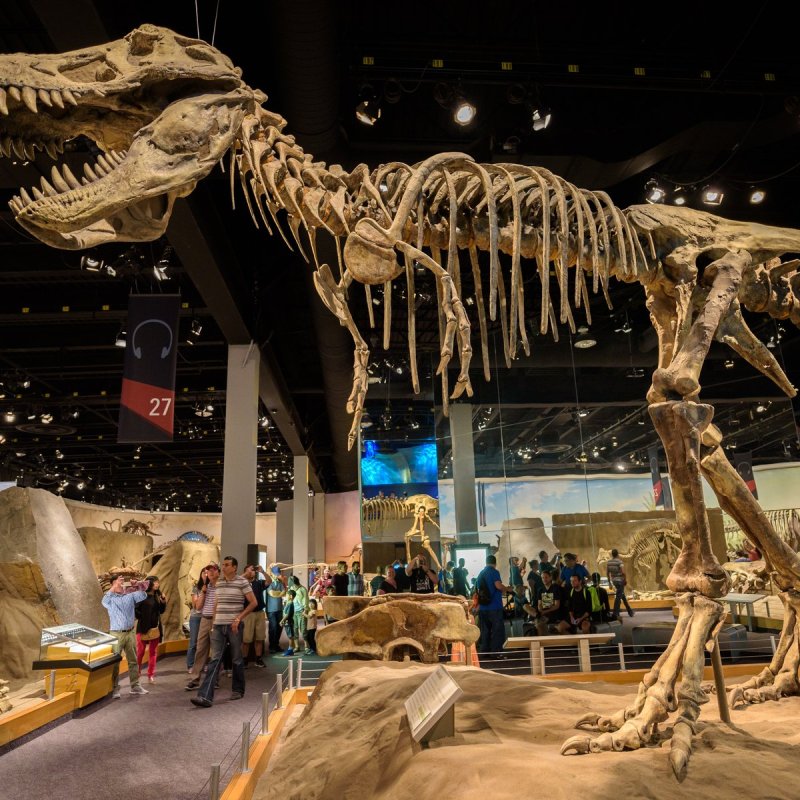
Dinosaurs used to roam the Earth, and now we roam the Earth looking for them. The two main ways to experience dinosaurs in Canada are to find the places where you might see evidence of them, and to visit places — usually museums — where dinosaur remains have been collected, curated, preserved, and displayed. Sometimes you can have both experiences at the same place.
Videos by TravelAwaits
There are a lot of great dinosaur museums in Canada, but unless they offer a chance to get outside and look for dinosaur evidence nearby, I didn’t include them here.
What counts as a dinosaur? The Natural History Museum in London says that dinosaurs had an upright stance, with their legs vertically under their bodies, unlike the sprawling stance of, say, crocodiles. The museum adds that, with the exception of a few birds, dinosaurs lived on land, not in the water.
Here are a few great places to have a dinosaur-themed adventure in Canada.
1. Fundy Geological Museum, Parrsboro, Nova Scotia
In 1984, expert fossil hunter Eldon George spotted some tiny tracks near Wasson Bluff, near Parrsboro. They turned out to be the world’s smallest dinosaur tracks. Soon after, two American paleontologists found a massive trove of fossil bones, including Canada’s oldest dinosaurs, who lived 200 million years ago.
The Bay of Fundy tides erode this shoreline daily, often revealing more fossils. At the Fundy Geological Museum, the staff keep watch, trying to capture significant finds before they wash away.
Visitors to the museum can see dinosaur fossils, the lab, and mineral displays, as well as learn more about the world’s highest tides. On the museum’s beach tours, you’ll have a chance to explore the bluffs and look for fossil footprints even older than the dinosaurs. You’ll need sturdy footwear for the moderate to challenging walking surfaces.
The most delicious dinosaur experience in Canada is certainly the Dinosaur Dig. After a guided walk, including 3 hours of paleontology field work at the actual research site, you’ll return to the museum for a tour, followed by a well-earned lobster dinner and a campfire on the beach. This is definitely a book-ahead, seasonal experience. What a fantastic day out!
Pro Tip: Don’t miss the nearby Joggins Fossil Cliffs, a UNESCO World Heritage site with fossils 100 million years older than the dinosaurs.
2. T.rex Discovery Centre, Eastend, Saskatchewan
The T.rex Discovery Centre in the small town of Eastend is home to some of the oldest dinos in Canada as well as one of the youngest. The Tyrannosaurus rex at the museum, nicknamed Scotty, is about 65 million years old. He’s the biggest Tyrannosaurus rex in the world and was found nearby.
The T.rex Discovery Centre is part of the Royal Saskatchewan Museum. Eastend is on the Red Coat Trail and gets its name from being at the east end of the Cypress Hills, a unique natural area.
A visit to the T.rex Discovery Centre itself will take an hour or two. This is beautiful open countryside, lovely to drive through in the spring, summer, and fall, but the weather is unpredictable in the winter.

3. Dinosaur Provincial Park, Brooks, Alberta
A UNESCO World Heritage site, Alberta’s Dinosaur Provincial Park is the best place in the world for dinosaur hunters. Since 1889, more than 400 dinosaur skeletons from 55 different species have been found here.
The park is open year-round, but for the best access to the bone beds, take one of the guided tours offered seasonally for a fee. The tours are highly recommended to help you get the most out of your visit. With a guide, you can go to the bone beds and find dinosaur fossils for yourself. There’s even a dinosaur checklist to help you understand your discoveries.
The visitor center’s extensive displays explain how the dinosaurs got here, what they looked like, how they lived, and how dramatically the climate and landscape have changed over the last 75 million years.
Dinosaur Provincial Park is hot and dry. It’s in the Badlands, which make up some of Alberta’s most stunning, but almost ghostly, scenery. The photogenic hoodoos, formed by erosion, look like a cross between giant mushrooms and the trunks of ancient trees.
This is a two-day experience minimum if you really want to get into it. The park offers lots of tips for your visit. Past visitors recommend booking tours and accommodations well in advance.
Dinosaur Provincial Park is not the same as the “Dinosaur Museum,” meaning the Royal Tyrrell Museum of Palaeontology in Drumheller. They are about 2.5 hours apart, and each deserves at least a day. You may see scientists from the museum out in the field at the park during your visit.

4. Royal Tyrrell Museum Of Palaeontology, Drumheller, Alberta
The Royal Tyrrell Museum of Palaeontology has one of the world’s largest displays of dinosaurs, along with extensive exhibits on many other prehistoric life forms. Designed to engage visitors of all ages and interest levels, it’s got a big window into the lab where paleontologists work on specimens.
The Dinosaur Hall is full of amazing dinosaur skeletons, both large (really large!) and small. Their poses and groupings clearly show who ate whom.
In the Cretaceous Garden, living plants create an environment similar to what existed 75 million years ago in southern Alberta. It’s very different from today’s arid prairie.
One of my favorite spots in this museum is the Burgess Shale exhibit. It depicts life some 505 million years ago, long before the dinosaurs, and it shows in lifelike color, at 12 times their actual size, what some of the underwater prehistoric creatures may have looked like. A few of them could be artists’ dreams of aliens, but they actually did exist, long, long ago. The Burgess Shale itself, a UNESCO World Heritage site, is in Yoho National Park in British Columbia.
A newer addition to the Tyrrell’s collection is the nodosaur specimen found in a northern Alberta mine in 2011. This is a remarkably complete dinosaur, armored plates and all.
There are guided outdoor walks at the Royal Tyrrell Museum, if you want to include them in a day trip. Be sure to check the museum’s website for hours (the museum is closed Mondays), current programming, and booking instructions.
The museum itself is designed to be barrier-free. The outdoor experiences and walks vary in accessibility.
Allow a full day to visit the museum, and be prepared for hot weather during the summer.
Pro Tip: Another Alberta museum farther south, Devil’s Coulee Dinosaur and Heritage Museum, tells the story of the first dinosaur nesting site discovered in Canada.
5. Philip J. Currie Dinosaur Museum, Wembley, Alberta
Northern Alberta and northeastern British Columbia have recently emerged as major dinosaur regions. The Philip J. Currie Dinosaur Museum is an award-winning museum close to a big dinosaur bone bed with amazing potential. The museum is named for Canada’s leading paleontologist, who has done extensive field work in Alberta and around the world.
From here, you can go on to Tumbler Ridge, another newer hot spot in the world of Canadian dinosaurs and paleontology.
Wembley is far enough north that it’s best visited in summer for the most convenient weather and access. It could be part of an Alaska Highway road trip or a northern fossil tour.
6. Tumbler Ridge Museum Foundation, Tumbler Ridge, British Columbia
The greater region of Tumbler Ridge is home to the world’s only known tyrannosaur trackways. In fact, the majority of the world’s known dinosaur tracks are here, and it was only recently that they were discovered and recognized for what they are. Unlike in southern Alberta, dinosaurs are somewhat new and exciting to British Columbian paleontology.
The Tumbler Ridge Museum Foundation grew up soon after two local boys discovered the dinosaur tracks in the year 2000. A community initiative, the foundation has attracted enough support to create a Discovery Gallery and the Peace Region Palaeontology Research Centre. This is the archive of the fossil finds.
The museum now offers tours to see the trackways. This video highlights the dinosaur finds at Tumbler Ridge, the potential for more, and the enthusiastic community support.
Before traveling to Tumbler Ridge, which is fairly remote, get in touch with the museums to learn how to become involved and how to visit the fossil sites.
